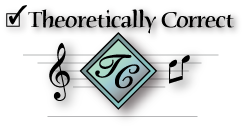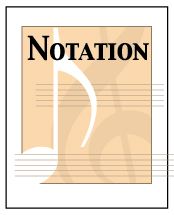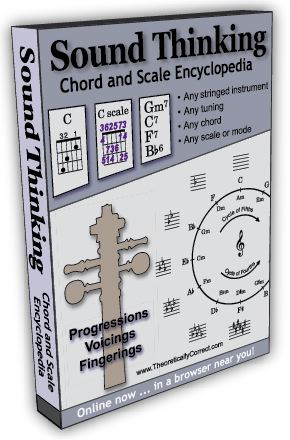Partial Guitar
A Partial Capo Tutorial and an
Introduction to Partial Capo Tablature Notation
Study the partial capo interactively with Sound Thinking
the ultimate online guitar chord finder
View any type of partial capo atop any guitar tuning.
NEW: Guitar–Utterly Simplified!
— join this weekly guitar workshop —
at Lamorinda Music in Lafayette, CA
Thursday nights, 6:30 - 7:45 pm. Sept 2017
Click for a flier and full description
of this fun group guitar class
for those new to guitar or DADGAD
|
These are regular, full-length Shubb
capos,
Model C1B (Brass)
Model C1 (Nickel)
|
This is a "5/6" Shubb partial capo.
Model C8B
The Paige Capo is particularly good for accurate intonation. When positioned properly, it won't stretch your strings as much as other capos. The only drawback is that it goes all the way around the neck, so you may find it slightly in your way, unlike the Shubb capo which give you lots of room because it doesn't wrap around the treble side of the neck.
Pagie 6-string Guitar Capo
D'Addario / Planet Waves Tri-action |
The Partial Capo
Partial capos have gained considerable popularity in recent years, and for good reason. A partial capo brings remarkable new possibilities to guitar, and it simplifies the instrument for beginners.
In over three decades of teaching I've found nothing that provides such a welcoming introduction to guitar, nor anything that affords instant accesss to sounds and styles not easily evoked by a guitar in standard tuning:
The partial capo provides a great method for introducing people to guitar.
- The initial barriers for beginning guitarists are quite predictable:
- Beginners are immediately faced with the large challenge of mastering chords (they must master the ability of accurately and simultaneously placing multiple fingers on the fretboard.) Even for the dutiful student it can take well over a month to learn the common three-finger chords, and some people lose interest before they master these basic chords.
- Even when a beginner has a reasonable facility with chords it's easy to get overwhelmed when trying to manage chords and strumming simultaneously.
- The partial capo addresses both of these issues by allowing beginners to play easy one-finger chords, freeing them to focus mainly on the challenges and fun of strumming. Learning chords and strumming is a tall order for anyone, therefore it's best to reduce the demands of one hand or the other. I recommend simplifying the left hand (i.e. the chord work) so the student care focus on the fun and creativity associated with strumming. A partial capo does just that. Ya get to make good noise right away. Instant rewards encourage continuing interest and dedication ...and that's especially important with kids.
- Although many partial capo chords are extremely simple to play, they sound lovely, full, and complex. For most of the chords you can strum all six strings, whereas in standard tuning, some chords sound better with just four or five strings strummed. This means more understanding and accuracy is involved when strumming in standard tuning.
- Now please bear in mind, the partial capo is not simply "training wheels" for beginning guitarist. Some very advance guitarists use one or more partial capos, in performance and on recordings, and there are some wonderful things that are possible only with a partial capo. It's a wonderful tool that I use all the time for fun and performance.
- a partial capo easily produces a convincing 'singer-songwriter' sound ... and it inspires creative guitarists to explore new territories. It adds a magical character to many familiar chords. New and interesting chords are readily discovered, and most are easy to play. Indeed singer-songwriters are the people who have been most experimental and creative with partial capos.
- a partial capo can instantly add a distinct sense of drone and Celtic flair—the type of drone that guitar's mainly expect only from retuning to an "open" alternate tuning. But with the partial capo, you get this sound without retuning any strings.
- the partial capo provides a simple way of exploring alternate tunings (like DADGAD, G-tuning, and Drop-D tuning, without having to any retuning. You'll find extensive discussion of this below.
- With a partial capo you get lovely "foot in both worlds" happenstance, where you can use the guitar as though its in standard tuning AND as though it's in the altered tuning. Since the guitar is not retuned to archieve the effects described, ALL fretted notes behave just like standard tuning, because .... well, they're still in standard tuning. Because of the capo, certain strings and all open string behave like the altered tuning.
- you can choose whatever base tuning you want—yes, that means that some people partial capo atop an alternate tuning! Crazy stuff, and a topic not covered on this page.)
Enough talk! Here's an example of the partial capo in action. Listen to this slow, gentle, intermediate-level strumming arrangement of an old-time American fiddle tune Sally Coming Though the Rye.
A Complete Introduction to Partial Reality
Many years ago a friend showed me a unique method of capoing a guitar. Instead of placing the capo across all six strings, he shifted the capo off the 6th string (the lowest string) leaving that single string uncapoed. The result is shown in the following Partial Drop-D diagram.
This is the simplest way to partially capo a guitar, and you don't need anything but a C-clamp style capo, such as a Shubb or Kayser capo:
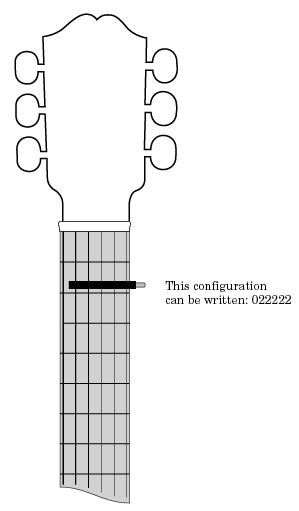
This technique of capoing less than all strings is generally called partial capoing.
The very popular partial capo technique emulates DADGAD tuning. This requires a specially designed partial capo like the Shubb C7B ... or some ingenuity and a hacksaw. A common name for partial capo is "cut capo", because originally people would cut them to the desired size with a hacksaw.
In the following example the capo depresses the 3rd, 4th and 5th strings at the 2nd fret:
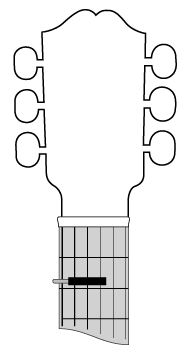
The partial capo is two frets above the nut. If you have a full capo on the guitar, place the partial capo two frets above the full capo.
Various type of Partial Capo techniques
There are many possible approaches to partial capo. In this article we'll explore four partial capo techniques in depth. Others techniques may be mentioned, but without much follow up. As we've seen, some partial capo techniques require special capos (not surprisingly called partial capos.) As you see in the following diagram, you can apply the 3-string Shubb C7B capo in at least three different ways. So the physical partial capo is but one aspect of a range of partial capo techniques.
Here are pictures of several common partial capo techniques:
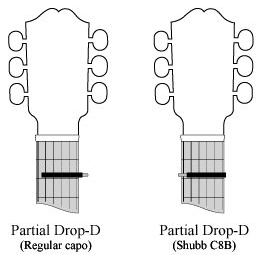
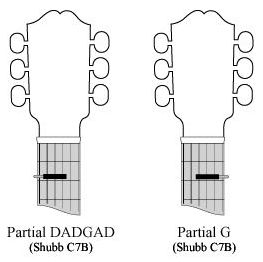
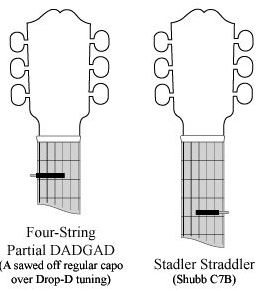
The first two diagrams show Partial Drop-D: the first using a regular Shubb capo; the next using the "dedicated" Shubb C8B capo, designed specifically as a "Drop-D capo.
The next two diagrams show the Shubb partial capo (Shubb model C7B) used for Partial DADGAD and Partial G.
Then there's a wonderful sawed-off approach, where you sacrifice a perfectly good Shubb capo under a hacksaw -- just takes a couple of minutes. The result is a Four-string partial DADGAD capo,
which provides a dramatically increased DADGAD effect -- the bottom four strings behave exactly like DADGAD! It's worth the trouble, and to date I've never seen a four string partial
capo for sale, although you can achieve this effect and MANY other possibilities with a non-contiguous capo like the Spider
Capo.
The last example shows the C7B capo in a third technique I call the Stadler Stradler, stumbled upon by Michael Stadler, as he says "before I knew any better!" Try playing in C position with this configuration: C, F and G chords.
One last point before delving in. My personal notes include Partial DBEAAD (aka D Cycle of 4ths), but I've forgotten what it means! So no image above or discussion. Rest assured that the world has gone some what crazy with "partial" experimentation: Multiple partial capos, partial capos atop altered tunings, non-contiguous capos. Hopefully this article with provide a general understanding of partial capoing, so you can enlightenedly explore the terrain.
My first encounter led to Partial Success
At first, when capoed to partial Drop-D, I was unable to fully comprehend my guitar's new behavior. Fortunately most of the surprises were pleasant, and I easily worked around the intermittent confusion.
Proceeding with only a partial understanding of partial capoing, I spruced up some incomplete and ailing finger-picking arrangements, and quickly transformed many of them into strong, satisfying, well balanced pieces. Additionally I developed a new found affinity for arranging and composing in the key of D. Here's a piece I wrote using partial Drop-D— the working title is Rising Sun.
Obviously much can be accomplished by pure experimentation, intuition, and just banging around ... yet with every insight doors open and previous knowledge applies, so I'll do my best here to impart what I've come to understand.
You can gain a significant insights with Sound Thinking, and online chord and scale finder, which can provide an overview of the guitar neck with any imaginable partial capo configuration. This link will take you to a page of links for predefined partial capo "scenes."
Partial Confusion — A foot in two worlds
There's a core issue that becomes obvious almost immediately, and it's one that's especially difficult to explain or comprehend.
Partial capoing causes the characteristics of two separate tunings to overlap—in a manner that initially seems quite mysterious. I'll comment on this duality many times as we proceed. To some extent you gain the benefits and limitations of each tuning. The prevailing effect is that of the guitar's actual tuning (usually standard tuning, but it could be any tuning. The other effect (i.e. the effect of the partial capo) is that the capoed strings behave just like the emulated open tuning; and the uncapoed open strings do too. So you can look at the guitar from either perspective: from the perspective of the base tuning; or from the perspective of the emulated tuning. The trick is in understanding when, where and why.
If you proceed at a rate similar to my initial progress, and if like me, your insights seem half illuminated and dissolve as quickly as they occur, rest assured, we'll review the principles regularly.
In a nutshell, here's an explanation of the physical side of partial capoing:
- the typically guitar remains in standard tuning . *
- a partial capo depresses less than all six strings.
* NOTE: For many years I had always capoed atop standard tuning. Then one day, in a flash of insight, I created one of my favorite configurations: the Four-String Partial DADGAD (explained below); where I capo over Drop-D tuning: DADGBE. Though I've used this technique for years now, I never seen anyone else do so. Nor have I seen capo over a base tuning other than EADGBE. (Hopefully, in keeping with the best spirit of the Internet, I'll get immediate reports from people who do so, and with dazzling results. Nevertheless, for now, other capo/tuning combinations are simply more than either of us should care to think about. Still, at some point you might want to explore.)
More Physical Considerations
Note: This section for intellectuals only ... and/or for those with plenty of previous partial capo experience! If you're new to partial capos, please skip this section!
Discontinuous Partial Capos
The Third Hand Capo allows for unlimited possibilities, and ensuing partial madness ... within "single fret" confine. With the Third Hand capo you can "dial in" a straight line of individual frets ... in a discontinuous manner if you like. For instance.
Partial A7 : 002020
Partial G: 300033
... but notice that all the frets must be the same.
Multi-fret Partial Capos
I don't know if anyone has invented a partial capo that spans two or more frets ... Probably someone ... somewhere. Here's a couple of conceptual examples:
002210 represents a two fret “A minor” partial capo.
032010 represents a three fret “C partial” capo.
Though I've never seen a capo that could do such thing, it would be fun to experiment with such a device. If you want to try this, but like me, can't find a dedicated tool for the task, you could gang up two or three Third Hand capos. The Third Hand Capo Company would surely endorse multiple purchases for this purpose ... be sure to ask for a bulk discount!
Multi-fret capoing would usually present a distinct intellectual drawback. As the block of adjacently capoed strings diminishes, so does the amount of applicable prior knowledge. With multi-fret capos it's unlikely that you'll capo enough contiguous strings to get a serious foothold in either domain. Prior knowledge becomes scattered.
With a singe-fret capo you capo a block of adjacent strings at the same fret. This gives you a huge leg up on the situation. You get a set of strings that acts like standard tuning: the open capoed strings. You also get a block of strings that behave like the emulated tuning: again this is the open capoed strings -- and if you have prior knowledge of the emulated tuning, you can apply your knowledge of chords and scales
Not too worry if you don't understand this discussion of multi-fret capos. It's really a side topic. You were warned on the way in.
It's also possible to partial capo other instruments. For instance, one could partial capo a mandolin so it emulates a fiddle's cross A tuning (AEAE). The capo configuration would be 2200 atop the standard mandolin tuning GDAE. I think I went wild one night with the mandolin capoed 0222.
Matters of Intonation
Anytime you place a capo on a guitar you invite intonation problems. Some capos disturb intonation less than others. I think Shubb's full six-string capos are pretty good in this respect, but I far prefer the Paige Capo shown here.
Due to its narrow footprint you can position a Paige capo so it rests partially on top of the fret, toward the back side. This positioning prevents the capo from stretching the strings. Read more about capo placement ...
Partial capoing is not exempt from intonation issue. Quite the contrary. Since you may often choose to work with two capos in place —a full capo for setting the key, and the partial capo as well — you double the chance for intonation problems. The presence of two capos can easily compound pitch issues."
Beyond capo design, there are significant factors at play. The prime aggravating factors are capo placement and capo pressure (i.e. user error.)
Capo pressure
When a capo is over tightened in place 'behind the fret' it stretches the strings down toward the fingerboard, raising the pitch slightly. The more the capo stretches the strings, the more they rise in pitch.
But don't our fingers press and stretch the strings all the way down to the fingerboard anyway? Actually no. Contrary to common belief, normal fingertip pressure does not press strings down to the fingerboard ... not even close. Unless there's some strenuous over-playing afoot, guitarists' fingers actually "tightrope walk" on the strings ... pressing the strings only slightly lower than the frets, NOT down to the fingerboard. If you've ever played an instrument like a pipa, where there is no fingerboard directly below the string, you know that it feels surprising normal, but it becomes strikingly clear that your fingers and strings are "hydroplaning" above the fingerboard.
The moral of the story: When applying a capo, use good capo placement and the minimum pressure required to attain clear tone and buzz-free playing. That said, now consider the following.
Capo placement has greater bearing on intonation than capo tension. For best results place your capo as close as possible to the fret. Best of all, place it resting part way on the fret (but not so far that the strings sound dull because the capo rubber partially damps them.)
When the capo rests partially on the fret (or immediately behind it) its clamping force is halted by the fret, the strings are minimally depressed by the capo, so the capo barely stretches them strings out of tune. If you halt the downward force by capoing at the fret, the amount of capo tension is of secondary concern. Capo partially 'on' the fret, or as near as possible.
The further it's placed from the fret, the more the capo will raise the pitch. A capo placed in the midway between the frets will surely cause the guitar to sound sharp.
Capos with wide pads may also affect pitch, even when well placed. Use a capo with a narrow pad, one that rests mainly on the fret. A wide, soft pad may wrap over the fret and press needlessly on the strings. I like a firm pad like you find on Paige capos. The Shubb pad is pretty wide; the Paige pad is quite narrow.
Even with good capo placement, strive to use the minimum adequate pressure.
Capo intonation summary
So OK, that oughta take care of it. If you're mindful of capo placement and capo tension, intonation should no longer be an issue, right?. Sorry. Even with careful attention to these factors, you'll probably need to tweak your tuning a little bit, especially after a partial capo is in place. Consistently I find I have to raise my 3rd string when capoing to Partial DADGAD ... and I can't explain why. (Some people argue against tuning while a capo is in place, but I've never found this to be a problem, and honestly it's a more practical and a more direct route to your goal.
Note to myself and others: I planned to position the capos closer to the frets in all the diagrams, to make the diagrams reflect my opinion regarding capo placement. As shown now, there is a noticeable gap between the capo and the fret. This needs to remain though, for clarity, because the diagrams look a little unclear when the capo overlaps the line that represents the fret.
Partial Capo / Full Clarity
Be smart whenever you explore tunings. If you look you find similarities between the new tuning and other tunings you're already familiar with. if not, you may end up needlessly intellectually adrift, when you're actually you're surrounded by familiar material.
The same advice applies to partial capoing. In introducing you to the world of partial capoing, I hope to convey enough understanding context so you can immediately apply your knowledge of standard tuning ... and apply any knowledge you may have of tunings that the partial capo can emulate.
The Principles of Partial Reality
You'll have the inside scoop on partial capoing if you remember the following four points.
When partially capoed, the guitar behaves like:
standard tuning
- when you play any fretted note — capoed or not
- when you play open strings that are capoed.
open tuning
- when you play any open string — capoed or not.
- when you play fretted notes on capoed strings
I'll return to these axioms numerous times and discuss them in detail as we look at various types of partial capoing. Just remember, this set of four rules explains “what portion of the guitar behaves like standard tuning, and "what portion behave like the open tuning."
Understandably, this may seem like an intellectual mind game, and it may continue to appear so until you work on a few pieces. Don't stretch too far to understand. Read and attempt to understand them; regardless of the result, move on and learn some partial capo material. They'll make more sense when you have a better perspective rooted in use of the partial capo.
For those familiar with open tunings (like Drop-D, G Tuning, A-Tuning or DADGAD), you'll be glad to know you can use a partial capo to instantly emulate such tunings -- without retuning! Indeed, this is one of the most instantly appealing aspects of partial capoing. When you partial capo, it's like you've re-tuned your guitar, but without tightening or loosening any strings. Slap on the clamp and you're "in another tuning." Because it's so quick it's great for performance situations. Additionally some altered tuning material works out better with a partial. I found that to be true with my arrangement of G-tuning arrangement of Soldier's Joy.
If you're unfamiliar with open tunings, stick with us. Partial capoing should prove useful by virtue of its own qualities and characteristics. Additionally, as mentioned, it provides a magical passport to the world of open tunings, and because it allows you to go there and back without the trouble of retuning your guitar, you get a quick and easy “partial” sneak preview of various tunings. You can explore the possibilities inherent to open tunings (much of it anyway) without the fuss of retuning.
Bear in mind though, a partial capo provides only a “partial” peak at altered tunings. Your guitar will NOT behave exactly like a re-tuned guitar, still there's plenty of common ground, there's lots of territory to explore ... and you can get there faster than you can say “thunk”(that's the sound of a Shubb capo as it latches into place!)
If you've been interested in open tunings, but haven't yet explored them, the partial capo is simplest way in. If things go well, you'll have so much fun, who knows, maybe someday you'll actually take the leap and retune your guitar! But consider yourself warned ... once you retune the guitar it will behave differently and you'll encounter the possibilities specific to true altered tunings.

Partial Drop-D
The partial capo configuration shown here is called "Partial Drop-D." It behaves 99% like standard tuning, and it's the simplest of partial capo techniques to understand. Click to view view chords and scales interactively for Parital Drop-D.
No special accessories are required. You only need a standard C-clamp capo to try it out. Put the capo on from the treble side, placing at the second fret, but only on the 1st through 5th strings. Leave the 6th string uncapoed, as shown.
For best results I recommend a Shubb capo, model C1 or CB1. They have a low profile and wont get in the way of your hand. (Shubb recently began manufacturing a Model C8B -- it's a better tool for the job, but for most guitars it is not necessary.)
Partial Capo Shorthand
To succinctly describe various partial capo positions without using pictures, I use a simple list of fret numbers. For the Partial Drop-D capo technique the fret list is: 022222. The zeroes represent uncapoed strings. The twos represent frets depressed by the capo. Ordinarily a capo covers all six strings, the short hand for a full capo on the second fret is: 222222. (The left most number represents the sixth string -- the lowest pitched string. Accordingly the right most number represents the first string. An x marks an unused or intentionally muted string.)
At times I use the same nomenclature in lieu of chord diagrams. Here are a few examples:
A minor: 002210
D: x00232
C7: 032310
Now ... get ready to witness some pretty interesting things, and a weird sense of "this can't be happening". And you may want to use Sound Thinking to interactively illustrate true drop-D and partial drop-D side by side.
With the guitar partially capoed, as shown, hold down a D chord and strum across all six strings. Notice that the sixth string sounds a deep bass note one octave lower than the 4th string. Most people think, “OK. What's the big deal? That's just like Drop-D tuning!” Indeed, in this respect, it's exactly like Drop-D tuning. But there's a huge difference. Any fretted note on the 6th string behaves like standard tuning! (Repeat this ten times out loud.You don't need to understand it; just remember it.)
Anyone familiar with Drop-D tuning knows that fretted notes on the 6th string sound two half-steps (two frets) lower than normal. And that why in you can't play a normal G chord fingering in true Drop-D, because the 3rd fret on the 6th string (ordinarily a G) sounds an F. So you'd have to play the frets 520003 or 5x0003 or 5x0033.
When you capo to Partial Drop-D, indeed you get the nice low root under your D chord BUT a three finger G chord (320003) plays the root you would expect to hear in standard tuning. Play 320003 to test this out. It sounds just like it would in standard tuning. Guitarists with previous Drop-D experience find this profoundly perplexing, yet simultaneously they're instantly surprised and delighted!
At this point many people now conclude “Oh! So its Drop-D tuning but with normal chord fingerings!” Well ...not exactly.
With a partial capo on your guitar, you've got a foot in two worlds. One moment your guitar acts like it in standard tuning. The next moment it acts like its in Drop-D tuning. As mentioned, it's essential to know when and why. And that's largely what this article is about. So if you've got remaining curiosity rewards are in store if you read on.
Some chord fingering work, some chords don't
Let's look at some "standard tuning" fingerings that DON'T work. Try an E chord (022100) or an E minor (022000). These sounds really bad. The notes on all three uncapoed strings sound incorrect.
To even the score, try another chord that works ... an F Bar: 133211. Or a G bar (355433) Delirium usually sets in about now, because these fingering don't work in true Drop-D tuning.
Confused? Take another look at the section at the top of this article, etitled: The Principles of Partial Reality. Rest assured, the entire explanation is succinctly expressed there. You needn't study and strain to fully understand the principles before proceed. However I'd advise that you review these points often and get those ideas percolating from the start. Then you've have a chance of recociling the suprises as they arise. And they will!
Back to our encounter with things cool yet mysterious.
D and F are not the only magical chords that perform this Drop-D defying feat. When your guitar is partially capoed, MOST of your guitar behaves just like standard tuning. In fact, the following "freedoms" and familiarities are true in ANY partial capo situation:
- All full bar chords work: Bm, F#m. Plus many of the "slash" chords: D/F#, C/G, and Am/G. (Bear in mind NONE of these fingerings work in Drop-D.)
- All closed chords work too -- all chords work except those that include an open 6th string. This includes a huge palette of closed jazz chords.
- Additionally ALL closed-fingering scales work as they do in standard tuning — that means any scale that does not use open strings. You can play all your closed position solos, riffs and scales ... yet instantly drop into "Drop-D."
As you explore this crazy crossover scenario (part Drop-D, part Standard) you'll find the benefits and limitations of each tuning intertwined. I'll say it again: the trick is to understand where and why. Keep referring to The Principles of Partial Reality.
Now I'd best warn you ahead of time, arrangements in Drop-D tuning that use fretted notes on the 6th string won't work verabitm in Partial Drop-D—fretted notes on the 6th string will sound two half-steps too high. Try it and see. Play around a bit imagining you're in standard tuning, and notice what works and what doesn't. I've found that I can usually rework my Drop-D arrangements, into something that's simpler
that you can alter many arrangement I've found that
Closing points. Where not in D anymore.
You'll probably find yourself thinking a lot in terms of the key of D—that's the nature of "Drop-D" And that's a good relative way of looking at the situation. But you're not in the key of D any longer—in fact, you simply can't get to D unless you tune the entire guitar down a whole step!
With the partial capo 022222 and D G and A chord fingerings, you're actually you're in E. So it might help if you think of this as Drop-D capo 2. Just add two half-steps (frets) to the letter name of the key you're fingering, and that will be the true concert key.
You can ratchet the entire tonality upwards though. Put on a full capo (111111) plus a partial capo (0333333) and then when you play your relative key of D, you're sounding the key of F. You can get to the key of G by double capoing 333333 + 055555
Have at it!
Three-string Partial DADGAD
This diagram shows the most common 3-string partial capo technique. It's called Partial DADGAD (or Esus). The guitar is tuned standard (EADGBE) and a partial capo is placed on the second fret of the 3rd, 4th and 5th strings.
— Click to interactively view chords and scales for Partial DADGAD —

If a guitarist places fingers these frets it produces an E Suspended 4th chord, hence the "Esus" alternate name:

This capo position and an Esus4 chord share the same text nomenclature: 022200.
The question arises, since this capo arrangement produces the sound of an Esus4 chord, why is it called Partial DADGAD? Here's a logic explanation.
DADGAD is the most common tuning besides standard tuning. Capoing 022200, as illustrated, emulates DADGAD tuning ... the name Partial DADGAD suggests the some of the functionality and relationship. If we named it by the true pitch of the open strings, EBEABE, most people wouldn't know we're talking about anything related to DADGAD!. Tkijv? <-- see that's the word "Right?" transposed up two letters! Hard to recognize, huh.
Explore the chord and scale possibilities of Partial DADGAD in Sound Thinking.
NOTE: DADGAD produces a Dsus4 chord. Partial DADGAD shares the same open strings but two frets higher. Notice I didn't say, "It's exactly the same thing." This article is largely about the subtle differences.
You can view an interactive comparison of Partial DADGAD and true DADGAD with Sound Thinking.
What's Partial DADGAD sound like?
This recording is an example of guitar accompaniment played with partial capo, which can sound just like DADGAD tuning. Listen:
Sandy Boys Mw/ partial capo guitar accompaniment (John Blasquez)
Here's another example of a "DADGAD" partial capo accompaniment:
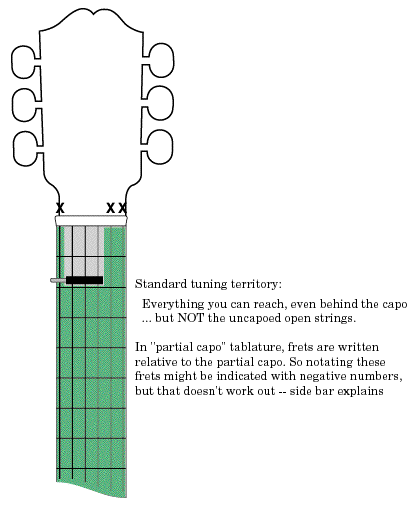
Three-string Partial DADGAD — Standard Territory
With a partial capo (like the Shubb C7B) in place, as shown, we're ready jump in.
Starting with the familiar, let's look at what's the same. Well, good news ... almost everything! Partial DADGAD emulates DADGAD tuning, yet simultaneously the guitar behaves almost entirely like standard tuning.
The green area in the diagram shows the portion of the neck that behaves like standard tuning:. It's everything you can reach — even behind the capo! Just stay off the uncapoed open strings!
No matter what type of partial capo technique you use, most of your guitar behaves just like standard tuning. Remember, the guitar is not re-tuned It is still in standard tuning, so naturally, all fretted notes behave like standard tuning! As with Partial Drop-D and other partial scenarios, all closed fingering scales work like standard tuning. As mentioned, you can even play behind the capo ... but I gotta repeat, stay off those uncapoed open strings. Touch 'elm and you shoot through the "worm hole" to the DADGAD parallel universe.
Here are some worm-hole examples that demonstrate this admonition:
The E fingering for standard tuning (022100). This sounds really bad, there's wrong notes on all three uncapoed strings. You're not in Kansas anymore. A minor (002210) has two wrong notes. Try standard tuning's three finger G chord (320003) -- here the open second string sounds wrong. Try a four finger C (332010) makes a very beautiful sound, but it's not a C, it's a Cadd9 chord: 1, 3, 5, 9.
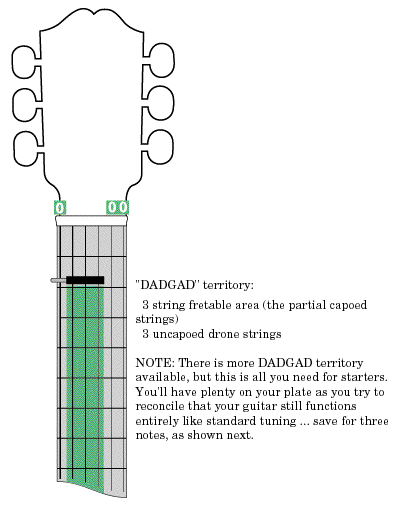
Three-string Partial DADGAD — DADGAD Territory
We've just see that most of the guitar behaves like standard tuning. A large portion of the guitar behaves like DADGAD as well. Here we'll explore the DADGAD part of the equation.
Remember the Principles of Partial Reality? Before exploring the DADGAD aspects of Partial DADGAD, we'd best review half of those:
- When partially capoed, the guitar behaves like open tuning
- when you play any open string — capoed or not.
- when you play fretted notes on capoed strings.
That's it. There's nothing else to know.
Granted, this information only useful if you know a finger-picking or flat-picking piece in DADGAD. Otherwise you have nothing to experiment with.
For those of you who know some DADGAD pieces, play something -- or a portion of something -- that only uses frets on the capoed strings. Chords are a good place to start. Then try a scale ... or a piece you know.
Everything works like normal DADGAD on the three capoed strings; you can also used the uncapoed open strings just like open strings in DADGAD. However, when you fret on an uncapoed string, things go awry. Indeed you've exited DADGAD reality, but there is a workaround for fretted notes on the uncapoed strings. Play them two frets lower than you would in DADGAD. Simple concept, but unfortunately it isn't always practical, and you may not want to relearn your pieces just to play them in Partial DADGAD. Whatever the case, it works, and it's a concept that will help you in reworking piece if you choose to do so.
I've reworked some pieces, lowing the frets as needed ... and find that I prefer them in Partial DADGAD. I hope to post some tablature soon.
What's so great about Partial DADGAD anyway ... or DADGAD for that matter? Why do so many people explore it? Why has it become the second or third most popular tuning?
For one, you can play a "lazy man's" I-IV-V chord progression with a single finger.
I: 000200
IV: 020000
V : 002000
With these chord voicings, the guitar drones simultaneously in a pleasingly ethereal way. It's that great sound often heard in backup to Celtic melodies. These easy chords also provide an excellent way of introducing kids to chords and strumming.
It shouldn't be hard to find information on chords and tablature for DADGAD on the Internet. Just remember the "principles" when applying this information to partial DADGAD. And bear in mind, just as all DADGAD
Partial Capo Music Notation
I don't know of any notation software that writes tablature for partial capo arrangements. If anyone knows of such software, please contact me.
Harvey Reid of Third Hand Capo, states, "The largest challenge now facing the partial capo issue these days is the issue of notation." Here's Harvey Reid's open letter to the guitar community about this problem.
Partial Notation
For clarity, I'll coin the term "partial tablature" when referring to tablature for a partial capoed arrangement.
Questions quickly surface when writing partial tablature. Which is the first fret? The fret above the nut or the fret above the partial capo? What about open strings? Some are at located at the nut; others are at the partial capo. What about frets behind the partial capo?
Open strings
Here are the pitches of the unfretted strings in Partial DADGAD (aka Esus), the capo positioned 022200 atop standard tuning EADGBE.

Open is open. No fingers down. These are all written as open strings: zeros on the tablature staff.
Fretted Notes
Frets are written relative to the partial capo in most pieces. However, in some arrangements guitarists play frets behind the partial capo (I'm referring to the uncapoed strings of course!) In these instances I write the frets relative to the nut ... this usually applies only to a short span of notes. (One could handle the situation differently by using negative numbers -- or zero frets -- but this approach has several drawbacks. It is possible to write all frets relative to the nut, but this hides some important open tuning relationships. )
Since the tablature system may vary back and forth -- relative to the partial capo, then relative to the nut -- some indicator is necessary. Color would suffice, but that would always require color printing or color copying, it and may prove problematic for color blind people. Perhaps changing font style to bold would serve as an adequate indicator.
I find that people are perfectly comfortable with a system I devised. Here's an example of my solution.
In the tune shown below (entitled Jeff Sturgeon), the black horizontal bar indicates when frets are relative to the nut (or in this case, to a full capo.) A notation package that fully supports Partial Capo tablature would need to address this matter, adjusting frets + or - accordingly.
Ideally tablature would be colorized as well, but as mentioned, there needs to be some non-colored method for denoting areas where frets are relative to the nut.
When a chord is played, and the chord includes frets below at or below the partial capo -- to avoid confusion -- all notes of the chord should be relative to the nut. In Jeff Sturgeon, an old-time fiddle tune from John Salyer, take note of the 4th fret at the end of measure 2. This could have been written as 2nd fret relative to the partial capo, but the note on the E string must be written relative to the nut -- that or a zero fret which I already recommended against using a symbol such as a zero or negative frets. For various reasons zeros should always indicate open strings.
Here are some unfinished, and not fully tested ideas about Partial Notation.
Some people think that frets on the guitar should have a one-to-one relationship with the frets in tablature. For instance, two frets above the Partial DADGAD capo should be written as a four, because indeed it's the forth fret on the guitar. But with this system you can't think DADGAD.
For the sake of discussion, let’s assume I’ve got a partial capo set to Partial DADGAD, like this: 022200. These notes (EBEABE) are all open strings -- no fingers depressed. So I want the tablature to show: 000000.
We can expand on this notion. All the capoed notes need to be written two frets lower than the actual pitch of the note. But that’s not the whole story. All fretted notes need to be written two notes lower than normal. (Unless you play behind the capo, or at the capo, then those notes are like normal, written relative to the nut).
I think that's correct ...
The notation of Sandy Boys is a melodic arrangement using a partial capo. While this arrangement contains no notes below the partial capo, I had to trick the software into notating open 2nd strings, by raising the pitch of those notes two frets.
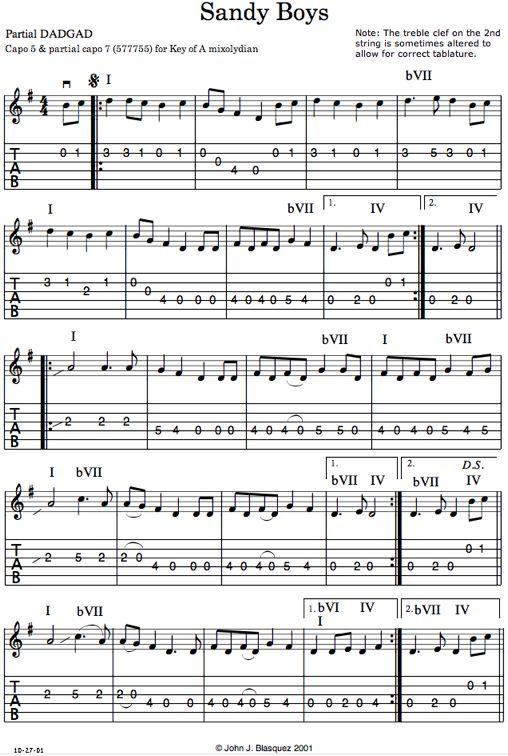
In Jeff Sturgeon, in the first three measure, the frets on the 3rd string vary from 2 to 4, but they actually represent the same spot on the guitar ... just from a different point of view.
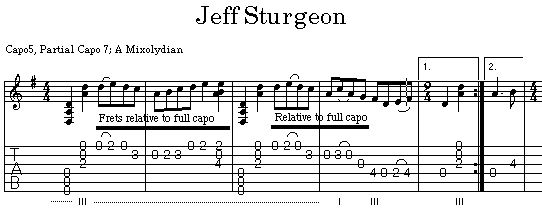
To trick the software into notating open strings and frets relative to the full capo, I had to alter the treble clef, so it no longer sounds correct when played back. (I had to so a similar thing with Sandy Boys)
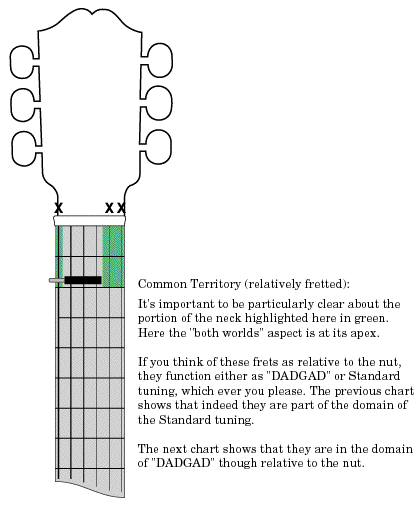
Three-string Partial DADGAD — Common Territory
The image here illustrates the "both words" aspect of partial tuning.
If you forget which world you're in, the guitar will promptly remind you with an unexpected pitches: some dissonance; some pleasantly surprising.
— No other supporting text on this topic —
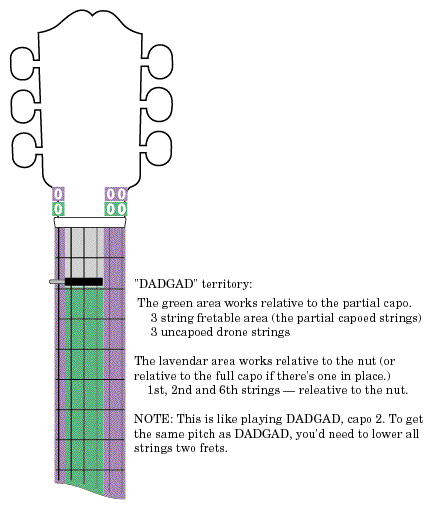
Three-string Partial DADGAD — Expanded DADGAD Territory
Here's an picture that illustrates an expanded concept of DADGAD territory, now including the frets at or behind the partial capo: the open strings; and the first and second fret above the nut.
— No other supporting text on this yet —.
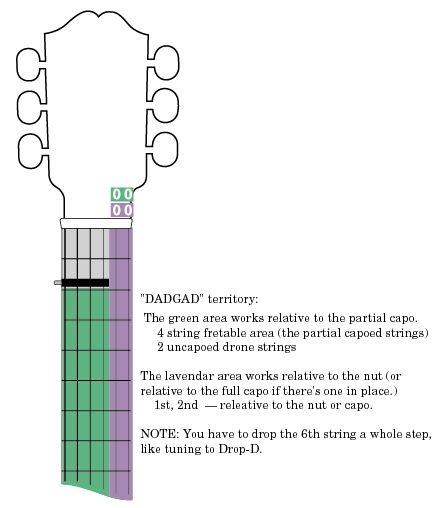
Four-string Partial DADGAD — Expanded Territory
The Partial DADGAD technique described previously uses a three-string partial capo (022200). This section introduces you to a four-string approach where you capo 222200 and lower the 6th string a whole step.
There's a big advantage to this approach: the bottom four strings behave exactly like DADGAD. Meanwhile the open first and second strings drone just like DADGAD
— View this partial capo/tuning configuration interactively —
NOTE: I'm not aware of any capo maker that manufactures such a capo, so it requires that you take a hack saw to a perfectly good capo (like a Shubb capo) and shorten it so it covers the four lower strings: the 6th through 3rd strings. You just need a vise, careful measurements, a hacksaw, a metal file, and about about three or four minutes. After you've cut the capo, file the rough edges, carefully cut the rubber sleeve to size with scissors, slide it into position, and you're ready to go.
Once the capo is in place (at 222200) tune the 6th string down a whole step, like Drop-D tuning. With this configuration you'll have a Partial DADGAD situation that perfectly emulates DADGAD fretting on the 3rd, 4th, 5th and 6th strings, as highlighted in green in the illustration provided here.
The only strings that don't fret like DADGAD are the 1st and 2nd strings ... however they behave like perfect DADGAD citizens when played open / and they behave like standard tuned strings when fretted. In other words, the lower 2/3 of the guitar is just like DADGAD, and ALL the strings fret like standard Drop-D tuning, so there a lot of fretted territory that will be familiar to anyone who plays in standard tuning.
Bass is an all important element in accompaniment, so of course the common complaint about three-string Partial DADGAD is that it's not DADGAD enough ... that it's not "6th string friendly." Earlier I explained that the three-string Partial DADGAD method gives you substantial access to DADGAD, however it leaves the 6th string off limits, except when it's played open. While this provides distinct advantages, it's an insurmountable problem to anyone wanting to play regular DADGAD chords or bass lines that use fretted notes on the 6th string. This four-string approach addresses that issue.
The only remaining limitation is that, well ... you can't play in D! When using a partial capo the lowest possible key is E; of course you can add a full capo to get to F, G, A, Bb, and even C. However you can lower the entire guitar tuning a whole step to DGCFAD, then you can play in keys D thru Bb. This limitation and solution apply to equally to the three-string and the four-string capo—you can't get to D without lowering the tuning of the entire guitar.
* You can fret notes on the 1st and 2nd strings, but not from a DADGAD point of view. And you can play melodies or improvise in Standard tuning frame of mind, just stay away from the open 1st
and 2nd string."
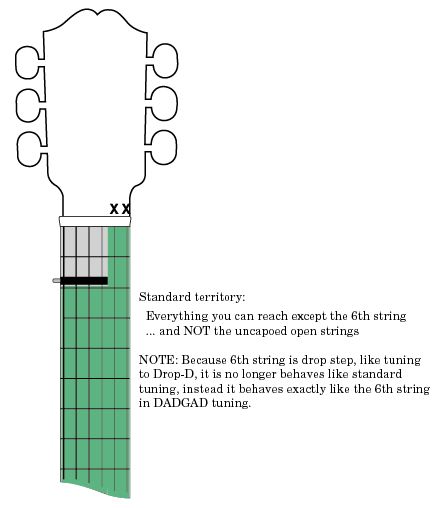
Four-string Partial DADGAD — Standard Territory
As it was with the three-string Partial DADGAD, the standard tuning territory is the entire fretable fingerboard, but NOT the uncapoed open strings.
Study partial capo interactively with Sound Thinking
...
the ultimate online guitar chord reference!
Click here for: Sound Thinking Documentation
Contact: partialCapo@singingwood.com
